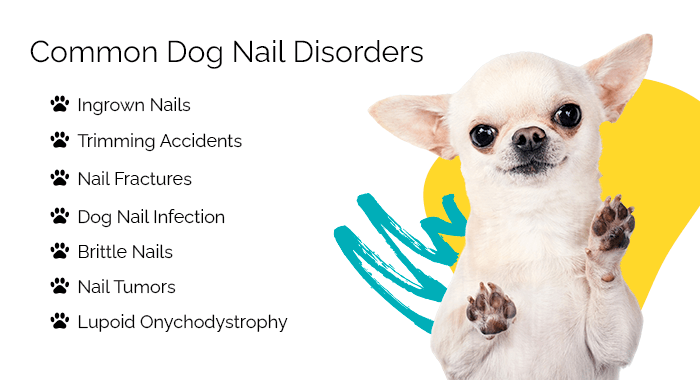
Nails are such a small part of a dog’s body and are often neglected during grooming. However, your pup’s claws serve many essential purposes. They offer protection and provide traction and balance when running and digging.
However, if your four-legged friend’s nails are not in good condition, they will not function properly and may create serious discomfort and pain. Unhealthy dog nails can result from various things, such as infections, injuries, poor diet, and more.
Luckily, you don’t need to be an expert in dog nail anatomy to know how to keep your pup’s claws in top condition. Continue reading to learn about the most common dog nail problems and how to prevent them.
Table of Contents
- Healthy Dog Nails 101
- Unhealthy Dog Nails Symptoms
- Causes of Nail Disorders
- Common Dog Nail Disorders
- How to Treat Unhealthy Dog Nails
Healthy Dog Nails 101
In order to know whether your dog has a nail problem, you’ll need to understand the difference between healthy and unhealthy dog nails. Healthy nails are oval-shaped — broader at the toe and narrower toward the tips. Like human nails, dog claws are made of the protein keratin.
Dog nails are typically a similar color to the skin of their paw pads. So if the paw pads are pink, the nails will be transparent with a visible light pink quick. Alternatively, if the feet are black, the nails will be too. Regardless of color, they should look and feel smooth, without any splits or cracks.
Your pup’s nails should not extend past the paw. If you notice they curve inwards towards the pads, this is a sign they are too long. Additionally, they should not touch the ground when your pup is walking. You can determine whether they are too long if you hear a clicking/tapping sound when they walk on hard surfaces like wooden floorboards.
Unhealthy Dog Nails Symptoms
If you think your furry friend is experiencing problems with their nails, there are a bunch of symptoms you should be on the lookout for. One unique telltale sign to keep an eye on is excessive licking or chewing of the paws, which usually points to pain or discomfort. However, there are an assortment of other symptoms you might notice, including:
- Inflammation and redness around the nail beds
- Limping or reduced mobility
- Deformation
- Discoloration
- Discharge from the nail bed
- Bleeding from the nail bed or quick
- Crusting around nails
- Misshapen nails
- Splitting nails
- Increased sensitivity
Causes of Nail Disorders
Your dog's nail health depends on a vast number of factors. Issues can arise for several reasons, from allergies to accidents and many things in between. Some of the most common reasons dogs experience nail problems include:
Fungus or bacteria
When fungus or bacteria goes underneath your dog's nails or into wounds on your dog's paws, your dog could be left with a severe nail disorder. Bacterial infections in a single nail are signs of another underlying issue, like an open wound. One common fungal infection is ringworm, which can seriously affect your dog's nails and cause extreme discomfort.
Paronychia is another infection caused by bacteria or fungus that grows when a dog's nail bed is irritated or injured. Once it starts growing, it's hard to cure and often requires surgery to relieve.
Trauma
Dogs are always on the go — chasing after a ball or sniffing around the area. Regardless of what they're doing, their first point of contact with their surroundings is their paws. They can easily break, crack, or split their claws on rocks or other foreign objects, causing them to bleed, limp, or not move altogether. Bacteria can enter your dog's cuts or wounds and fester into infections and other nail disorders.
Genetics
While rare, some nail bed infections found in dogs are thought to be linked to problems in a dog's immune system, caused by their genes. Studies have shown that some nail disorders are more prevalent in certain dog breeds, with some conditions being passed down and inherited. Diseases like onychogryphosis and lupoid onychodystrophy are conditions many believe have connections to genetic predispositions.
Nutrition
If your pup isn't fueled with the right balance of vitamins, minerals, and nutrients, they could deal with various nail problems. Subpar nutrition can lead dogs to have brittle nails that break, crack, and split regularly. Minerals like calcium and phosphorous play significant roles in creating a healthy and strong nail structure. Protein is another necessary nutrient to ensure your furry friend's nails are flourishing.

Common Dog Nail Disorders
The causes of unhealthy dog nails range from non-serious and easily treatable to severe. Here are seven of the most common dog nail problems:

1. Ingrown Nails
If dogs spend a lot of time outside on rough terrains, they will likely file their nails naturally. However, the rate at which dog nails grow differs from canine to canine, and most will require nail clipping from time to time.
Overgrown nails are a common problem when nails are not regularly trimmed and taken care of. If they grow too long, they can cut into the paw pads and lead to infection. As you can imagine, an ingrown dog toenail can become extremely uncomfortable and painful.
2. Trimming Accidents
At each nail’s base is a bundle of nerves and blood vessels called the quick. If you are unsure how to trim dog nails, you may accidentally cut too deep into this area, causing bleeding and pain. We recommend using a dog nail grinder to prevent trimming accidents, as it’s the safest tool available for inexperienced groomers.
3. Nail Fractures
Dogs spend countless hours on their feet, and their nails can break or split from time to time. Injuries can also happen when dogs get their feet trapped or squashed under something heavy. Depending on how severe the breakage is, a broken dog nail from injury can cause your pup discomfort.
Inflammation, bleeding, and nail discoloration are common visible signs of nail fractures. They're often susceptible to infection, so wounds should be kept cleaned and bandaged up when outside.
4. Dog Nail Infection
There are two types of infections that can affect the feet and cause unhealthy dog nails. Typically, the cause will be either a dog nail fungus or bacterial infection. You can usually tell which one the culprit is by the visible symptoms.
Fungus infections, such as ringworm, will typically create a crusty appearance on the nail’s surface and surrounding skin tissue. On the other hand, bacterial dog nail infections will have more inflammation and redness and result in discharge from the nail bed.
5. Brittle Nails
Suppose your dog seems to be cracking or splitting their nails regularly — they're likely missing essential nutrients in their diet. Since dog claws contain over 90% protein, a dog without enough protein in their diet they will experience problems with their nails.
Weak, dry, and brittle dog nails reduce the functioning of this part of the paw and can cause pain, too. However, you can make brittle nails healthy again with some simple changes in your dog’s diet.
6. Nail Tumors
Dogs can develop tumors anywhere on their body, including on their toes close to the nail beds. Tumors appear as solid, raised skin masses on the toe known as nodules or papules. They are usually accompanied by swelling and can cause ulcers and damage nails on the affected toe.
Subungual melanoma and squamous cell carcinomas are two types of tumors that can grow. While squamous cell carcinoma tumors typically affect only large breed dogs and black-colored dogs, melanoma is most common in:
- Poodles
- Dachshunds
- Scottish Terriers
- Golden Retrievers
- Schnauzers
- Rottweilers
7. Lupoid Onychodystrophy
Lupoid onychodystrophy is a skin disease that affects the cells around the nails, making them brittle, thick, and deformed. The condition can cause the nails to grow at weird angles and affect the dog’s mobility. Toenails can fall off in severe cases, resulting in pain and susceptibility to secondary infection.
Lupoid onychodystrophy is an immune-mediated condition, meaning it is triggered by an overactive immune system. Some breeds are more prone to it than others, such as Gordon Setters and German Shepherds.
How to Treat Unhealthy Dog Nails
The type of treatment will depend on the specific cause. Therefore, it’s essential to book an appointment with a veterinarian to receive a diagnosis before attempting to treat it.
Your veterinarian will prescribe the necessary medication, for example, antibiotics for a bacterial infection or itraconazole for fungal infections. Surgical removal may be required if the cause is due to a tumor.
Because dogs need to use their feet throughout the day, many dog nail problems take a while to heal. Therefore, your veterinarian may suggest restricting movement as much as possible and bandaging the foot before taking your pup outside.
Some causes of unhealthy dog nails are preventable. Therefore, there are several lifestyle changes and additions you can make to help keep your pup’s nails in top condition.
- Healthy diet: Ensure you are feeding your dog a balanced diet that contains the proper nutrients for their age, breed, and lifestyle. You should look for food with protein as one of the top three ingredients, such as chicken-based dog food. If this is not the case, the food will be high in carbohydrates and low in protein, which can cause brittle nails and lead to obesity.
- Omega-3 supplements: An easy way to boost your dog’s hair, skin, and nail condition is to give them an Omega-3 supplement every day. This fatty acid from fish oil will moisturize your dog’s nails, prevent splitting, and promote growth.
- Biotin supplements: Biotin is a B vitamin used to treat several dog nail problems, such as lupoid onychodystrophy. However, it is a safe supplement to give your dog every day because it is water-soluble, so any excess will excrete in the urine.
- Regular grooming: As your dog’s guardian, you should schedule time regularly to care for their feet. This involves tasks like cutting their nails to prevent ingrown claws, trimming hair tufts between the toes, and wiping their feet with antibacterial wipes to keep infection at bay. Grooming also allows you to notice any fractures or issues before they get serious.
- Paw pad care: If your dog’s paw pads become dry or chapped, this increases the chance of secondary infections that can affect the nails. Therefore, avoid taking your dog out for walks when the pavements are hot, use dog paw balm, and consider getting them some booties!
Final Thoughts
By understanding the symptoms of unhealthy dog nails, you’ll be able to notice anything concerning, like excessive licking, and take action immediately. Moreover, by following the prevention tips above, you can keep your beloved furry friend happy, healthy, and pain-free.
Last Updated on July 27, 2023 at 8:00 AM

